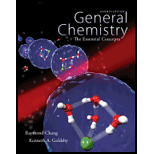
Interpretation:
The significance of Mendeleev’s periodic table has to be described briefly
Concept Introduction:
In Mendeleev’s periodic table the elements were arranged by increasing number of atomic weight. Group of elements with similar properties were arranged together.
Mendeleev’s classification
In Mendeleev’s classification the elements were grouped according to their properties. Equal importance was given for the undiscovered elements; some gaps were left for the elements yet to be discovered.
Explanation of Solution
In Mendeleev’s periodic table the elements were arranged by increasing order of atomic mass, group of elements with similar properties were placed in to vertical column in the table.
Mendeleev named eka-aluminium and eka-silicon for the undiscovered elements and predicted its properties, Gallium and Germanium were discovered and its properties matched the predicted properties of eka-aluminium and eka-silicon respectively.
The significance of Mendeleev’s periodic table was described briefly.
Want to see more full solutions like this?
Chapter 8 Solutions
Workbook with Solutions to Accompany General Chemistry
 ChemistryChemistryISBN:9781305957404Author:Steven S. Zumdahl, Susan A. Zumdahl, Donald J. DeCostePublisher:Cengage Learning
ChemistryChemistryISBN:9781305957404Author:Steven S. Zumdahl, Susan A. Zumdahl, Donald J. DeCostePublisher:Cengage Learning ChemistryChemistryISBN:9781259911156Author:Raymond Chang Dr., Jason Overby ProfessorPublisher:McGraw-Hill Education
ChemistryChemistryISBN:9781259911156Author:Raymond Chang Dr., Jason Overby ProfessorPublisher:McGraw-Hill Education Principles of Instrumental AnalysisChemistryISBN:9781305577213Author:Douglas A. Skoog, F. James Holler, Stanley R. CrouchPublisher:Cengage Learning
Principles of Instrumental AnalysisChemistryISBN:9781305577213Author:Douglas A. Skoog, F. James Holler, Stanley R. CrouchPublisher:Cengage Learning Organic ChemistryChemistryISBN:9780078021558Author:Janice Gorzynski Smith Dr.Publisher:McGraw-Hill Education
Organic ChemistryChemistryISBN:9780078021558Author:Janice Gorzynski Smith Dr.Publisher:McGraw-Hill Education Chemistry: Principles and ReactionsChemistryISBN:9781305079373Author:William L. Masterton, Cecile N. HurleyPublisher:Cengage Learning
Chemistry: Principles and ReactionsChemistryISBN:9781305079373Author:William L. Masterton, Cecile N. HurleyPublisher:Cengage Learning Elementary Principles of Chemical Processes, Bind...ChemistryISBN:9781118431221Author:Richard M. Felder, Ronald W. Rousseau, Lisa G. BullardPublisher:WILEY
Elementary Principles of Chemical Processes, Bind...ChemistryISBN:9781118431221Author:Richard M. Felder, Ronald W. Rousseau, Lisa G. BullardPublisher:WILEY





